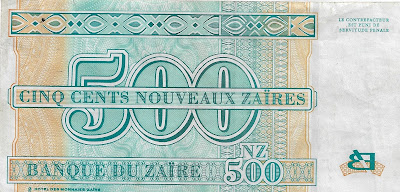2496) A 500 Zaire Banknote (formerly Zaire) presently Democratic Republic of Congo (DRC): Banknote issued by the Banque du Zaire (Bank of Zaire): Date of Banknote issue: 30.01.1995:
Links to posts on Zaire/Democratic Republic of Congo (DRC):
About Zaire - A brief:
Zaire (or the Republic of Zaire (French: République du Zaïre) was a Congolese state from 1971 to 1997 in Central Africa that was previously and is now again known as the "Democratic Republic of the Congo".
Zaire was, by area, the third-largest country in all of Africa (after Sudan and Algeria), and the 11th largest country in the world.
With a population of over 23 million inhabitants, Zaire was the most-populous officially Francophone country in Africa, as well as one of the most populous in Africa.
The country was a one-party totalitarian dictatorship, run by Mobutu Sese Seko and his ruling Popular "Movement of the Revolution Party".
Zaire was established following Mobutu's seizure of power in a military coup in 1965, following five years of political upheaval following independence from Belgium known as the "Congo Crisis".
Zaire had a strongly centralist constitution, and foreign assets were nationalised. The period is sometimes referred to as the "Second Congolese Republic".
A wider campaign of Authenticité, ridding the country of the influences from the colonial era of the Belgian Congo, was also launched under Mobutu's direction.
Weakened by the termination of American support after the end of the Cold War, Mobutu was forced to declare a new republic in 1990 to cope with demands for change.
By the time of its downfall, Zaire was characterised by widespread cronyism, corruption and economic mismanagement.
Zaire collapsed in the 1990s, amid the destabilization of the Eastern parts of the country in the aftermath of the Rwandan genocide and growing ethnic violence.
In 1996, Laurent-Désiré Kabila, the head of the Alliance of Democratic Forces for the Liberation of Congo (AFDL) militia, led a popular rebellion against Mobutu.
With rebel forces successfully making gains westward, Mobutu fled the country, leaving Kabila's forces in charge as the country restored its name to the Democratic Republic of the Congo the following year, and he passed away less than four months later while in exile in Morocco.
Evolution of the Zaire Banknotes:
The Zaire was the unit of currency of the Democratic Republic of the Congo and then of the Republic of Zaire from 1967 until 1997.
There were two distinct currencies. All but six of the 79 series of banknotes issued bear the image of Mobutu Sese Seko.
1) Zaire Banknotes (1967-1993):
A popular Movement of the Revolution slogan was "Long live the three Zs! Zaire our money, Zaire our river, Zaire our only nation!"
-The Zaire, subdivided into 100 Matuka, each of 100 Sengi replaced the Congolese currency, which was hitherto in circulation.
- In 1967, the National Bank of Congo introduced notes for 10, 20 and 50 makuta, 1 and 5 Zaires (also shown as 100 and 500 makuta).
- In 1971, 10 Zaire notes were introduced.
- In 1972, the Bank of Zaire started issuing notes for 1, 5 and 10 zaires, followed by 50 makuta notes in 1973.
- 50 Zaïre notes were introduced in 1980, followed by 100 Zaires in 1983, 500 Zaires in 1984, 1000 Zaires in 1985, 5000 Zaires in 1988, 10,000 Zaires in 1989, 2000, 20,000 and 50,000 Zaires in 1991 and, finally, 100,000, 200,000, 500,000, 1,000,000 and 5,000,000 in 1992.
The Sengi was however issued as a 10 Sengi coin only.
Interesting posts from Sierra Leone:
Links to posts on Zaire/Democratic Republic of Congo (DRC):


Santosh Khanna has commented:
ReplyDelete"Very nice informative post. Thanks."
Thank you, Khanna sahab.
ReplyDelete